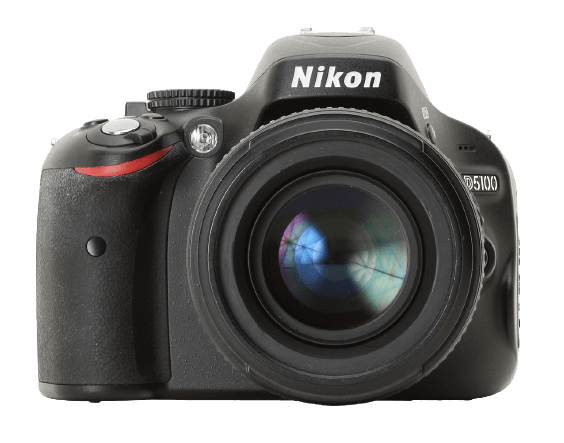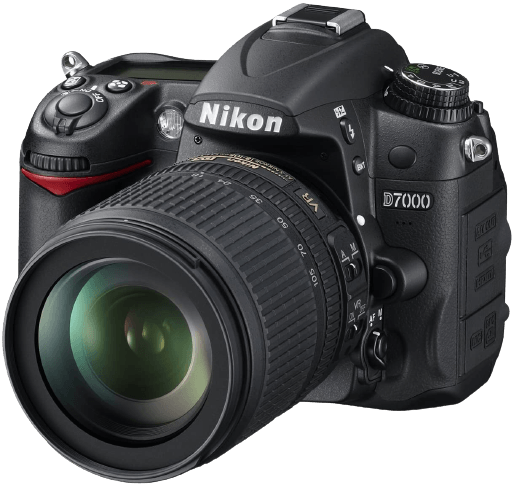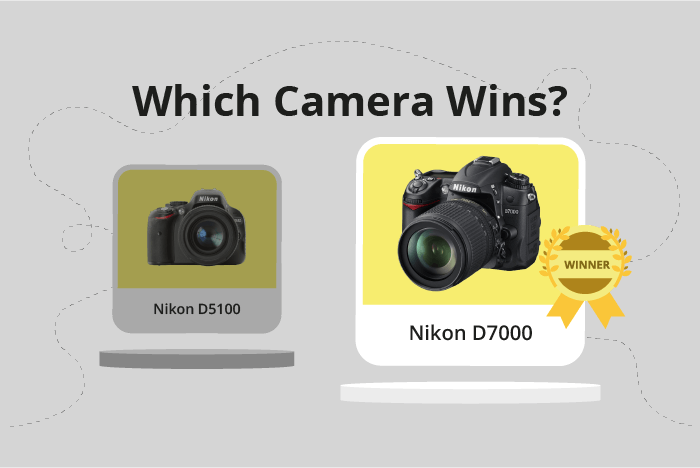Nikon D5100 vs D7000 Comparison
Nikon D5100

Nikon D7000

The Nikon D7000 comes out ahead with a score of 54, while the Nikon D5100 scores 49. Both cameras are DSLR models announced in 2010 and 2011, respectively. They share similarities such as camera type and size, with the D7000 measuring 132 x 105 x 77mm and the D5100 at 128 x 97 x 79mm.
The D7000 excels with a higher score, offering better performance and features. However, the D5100 has its advantages, like being lighter at 560g compared to the D7000’s 780g. This makes the D5100 more convenient for travel or extended shooting sessions.
Ultimately, the Nikon D7000 is the superior camera due to its better performance, but the Nikon D5100 is a viable alternative for those seeking a more affordable and lightweight option.
Nikon D5100 vs D7000 Overview and Optics
The Nikon D7000 prevails in optics with a score of 55/100, while the Nikon D5100 trails closely behind at 52/100. Both cameras share several specifications, such as the 16.2-megapixel count, CMOS sensor type, Expeed 2 processor, 80 DXOMARK score for the sensor, APS-C sensor size, and absence of image stabilization. Moreover, the Nikon D5100 has a Nikon F DX lens mount, while the D7000 has a Nikon F lens mount.
The D7000 outperforms the D5100 with its faster shooting speed of 6 frames per second, compared to the D5100’s 4 frames per second. This advantage enables the D7000 to capture fast-moving subjects and action shots more effectively. Additionally, the Nikon F lens mount on the D7000 offers greater compatibility with a wider range of lenses, providing users with more options to enhance their photography experience.
On the other hand, the D5100 does not surpass the D7000 in any specific optical aspect. However, its slightly lower score and similar specifications imply that the D5100 still delivers quality performance and could be a suitable choice for those who prioritize affordability or have specific needs that the D7000 does not address.
Taking into account the respective scores and specifications, the Nikon D7000 stands out as the superior option in terms of optics, particularly due to its faster shooting speed and broader lens compatibility. While the Nikon D5100 does not outshine the D7000, it remains a viable alternative for those seeking a more budget-friendly option without compromising too much on performance.
Nikon D5100 vs D7000 Video Performance
The Nikon D7000 and D5100 are close competitors in video performance. both models offer a solid option for everyday video use.
Nikon D5100 vs D7000 Features and Benefits
The Nikon D7000 wins the features comparison with a score of 54/100, while the Nikon D5100 scores 41/100. Both cameras share some common specifications, such as a 3-inch screen size and a screen resolution of 921,000 dots. Neither camera has a touchscreen or GPS, and both lack Bluetooth connectivity.
The Nikon D7000 surpasses the D5100 in certain aspects. The most notable advantage is the presence of Wi-Fi connectivity, which allows for easier transfer of photos and remote control of the camera. This feature is absent in the D5100, making the D7000 more convenient for users who value wireless connectivity.
On the other hand, the Nikon D5100 does have an edge in one area: the flip screen. This feature enables users to capture images from various angles, making it more versatile in shooting situations where a fixed screen may be limiting. However, this advantage does not outweigh the benefits offered by the D7000’s Wi-Fi connectivity.
Taking these factors into account, the Nikon D7000 proves to be the superior camera when it comes to features. The Wi-Fi connectivity adds a level of convenience and functionality that the D5100 lacks. While the D5100’s flip screen is a useful feature, it is not enough to overcome the D7000’s overall advantage in this comparison. Therefore, the Nikon D7000 is the recommended choice for users seeking a camera with better features.
Nikon D5100 vs D7000 Storage and Battery
The D5100 outperforms the D7000 in battery life, with a capacity for 2200 shots using an EN-EL14 battery. In contrast, the D7000 only supports 1050 shots with its EN-EL15 battery. This significant difference in battery life makes the D5100 a more reliable option for extended shooting sessions.
Nikon D5100 vs D7000 – Our Verdict
Are you still undecided about which camera is right for you? Have a look at these popular comparisons that feature the Nikon D5100 or the Nikon D7000:

